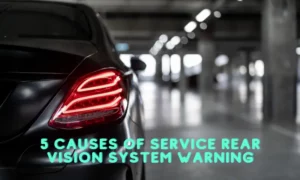Having a drive in your Chevy under a scorching sun or near 0ºC freezing temperature can be treacherous. But with the car’s climate control system, your driving performance gets reinforced for a smooth ride. It not only neutralizes extreme heat or cold, but climate control also ensures comfort. In addition, the feature protects you and your car from undue exposure to extreme climatic conditions.
But when this feature fails to function, a typical Chevy will show its mischief. Why does Silverado’s climate control have issues? Let’s find out in this short article.
What Causes Chevy Silverado Climate Control Problems?
Here are four common issues that can cause your Chevy Silverado climate control not to work.
- Faulty Climate Control Panel
- Dead actuator
- Dual climate control
- AC Blowing Hot air
Let me take a few minutes to explain what each issue does before looking at the possible fixes.
Faulty Climate Control Panel
The climate control panel, otherwise called the AC air handler, electronically controls the function of the AC system. The panel is connected to the HVAC system with four connectors. Hence, it’s responsible for reading data in the cabin and outside the vehicle. The ACCM uses the data to regulate air distribution and airflow rates while keeping the AC temperature level normal.
However, a faulty panel might cause a temperature rise inside the cabin. This is due to poor airflow and distribution as the panel is unable to read data. The absence of light on the AC controls or knobs is a clear symptom of a failing panel. But I’ll recommend a scan of your AC system.
Possible Fix: Usually, a climate control panel will fail in case there’s a blown panel fuse. The fuse is usually located in the unit’s control board. Damage to any of the four connectors that link the panel to the system can cause the panel to malfunction. You’ll need to replace the blown panel fuse with a new one. Open the fuse box under your car hood and check for the dead fuse. There are several fuses in the box and you need to be sure which one controls the climate control panel.
Dead Actuator
Once you can no longer control the airflow into your car, it’s time to check the AC actuator. It may be dead. While this is a rare problem, it’s not impossible to imagine. While there are other reasons, a faulty AC fan motor is the first culprit. The fan helps blow and control the climate and airflow into your car and the AC system.
With a defective engine, the fan won’t be able to work as it should. Hence, you’re likely to hear some rattling, humming, or buzzing noise once you switch on the climate control. Besides, the fan may fail to start or stop. As a result, there won’t be cold airflow. Your car AC may also run intermittently or there are still or slow rotating blades.
Possible Fix: As I’ve hinted, a faulty AC fan motor is the first suspect if you find out that the actuator is malfunctioning. The thing to do is to repair or replace the fan motor. If theproblem is not the fan motor itself, but the resistor, you’ve got to change tactics. An overheated voltage-dropping fan motor resistor will cause the AC fan not to work at quieter speeds. The first thing here is to replace the resistor block. Guess what? It’s pretty straightforward to do. If the problem persists, you may need to take the car to a technician for a further diagnosis.
Dual climate control
This is the most common issue with faulty climate control in a Chevy Silverado. Dual climate control occurs when the AC blows cold on one side and hot on the other side of the cabin. For example, the driver may be experiencing cool and cold air while the passenger is feeling hot. You’ll notice this usually when you turn the climate control button to release hot or cool air on either side of the cabin.
Possible Fix: While this is mostly an issue from Chevy’s design, the automakers have tried to fix the problem. Chevy upgrades in newer and more recent generations of Silverado have seen the problem nearly disappear. However, if you experience the issue, the best fix is to reset your climate control devices. Reprogramming means that you’re resetting the actuators on both sides of the cabin. The process requires the following steps:
- Disconnect the battery terminal cables
- Allow them for 15 minutes.
- Reconnect the cables again
- Insert the ignition key (don’t start the engine yet)
- Turn the key to the ON position and wait for about 5 minutes
- Turn off the key and remove it
- Repeat steps 5 and 6 three times
- Check if the climate control is reset and working
However, if the problem remains, replacing the actuator may be the thing to do.
AC Blowing Hot air
Your Chevy Silverado’s climate control will also malfunction if the AC is constantly changing from hot to air at random intervals. There are certain reports that Silverado’s AC only blows hot, regardless of the settings. This problem happens intermittently and randomly, too. In fact, I have many Chevy Silverado users complaining. The AC may be blowing cold air for some time and then suddenly becomes hot.
How would you feel driving in the scorching sun and only for your car AC to be blowing hot air?The possible reason you may experience hot-cold air from the AC isthat you havea faulty temperature sensor. A bad sensor won’t be able to read data correctly. The more accurate the data from the sensor, the better for the climate control module. Hence, the module won’t be able to regulate the amount of heat or cold air that is released into the cabin
Possible Fix: Whenever you notice random cold-hot air blowing, the thing to suspect is the temperature sensor. Another possible issue may be dead actuators. Changing the sensor is the best bet. Should you suspect and change just like that? No, there’s the need for a diagnosis to be sure what’s wrong. As you’ve read above, the solution to dead actuators is reprogramming. You should reset the actuators and AC system. Take the steps above and get things done quickly.
Final Thoughts
Guess what? Faulty climate control is one of the common issues of any model of Chevy. You’ll need to attend to this problem as quickly as you discover it. Otherwise, letting the issue linger may cause damage to other components of the AC system. I hope this article helps.







